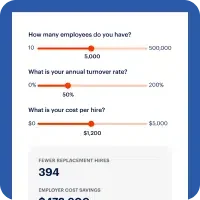Most business owners know there are significant costs associated with ignoring employee engagement. Engagement directly correlates to productivity, and heading into the fourth quarter, extra effort may be the component you need to reach your year end-goals.
Lack of employee engagement could also lead to attrition that can bleed into quarter one, causing headaches and increased spending to start your fiscal year.
Stay ahead of the curve. Consider these telltale signs that your employees are disengaged and learn what you can do to manage the situation.
1. Performing well – but never exceptionally
Meeting a goal is something we typically celebrate in the workplace. It’s great to know your employees are performing to a certain standard. But, when is the last time you looked at the goals; are they too low for some of your top performers?
When a job starts to feel too easy, it can become boring. This sign is an easy one to miss, but don’t be fooled into thinking that employee engagement is high simply because the person is achieving his or her goals for work. Rather, pay attention to your employee’s happiness and eagerness. Are they still feeling challenged? Are they going above and beyond even when they are meeting goals and deadlines?
2. Lifestyle changes – for the worse
Picking up unhealthy habits can be an obvious indicator that your employee isn’t happy, but it can also be a hard one to catch.
Observe how often the smokers on your team head out for a cigarette break. Has the cadence picked up? Ask your employees how they spend their weekends or evenings. Are they staying in and binge-watching television more than getting out and enjoying some fresh air?
If you notice these changes, ask what stresses your employees are feeling. Studies show financial stress is one of the primary reasons why employees quit. This stress is also something employers can assist with.
3. Withdrawn from company culture
It’s harder to quit a job when you’re involved in company activities. A workplace can feel like a home away from home. But, if you don’t actively participate in the events offered at the workplace, it’s easier to feel trapped.
Keep an eye out for typically extroverted employees who are starting to exclude themselves from company functions. Or employees who once sat in the front row during company meetings that no longer attend with the same hunger. The sooner you catch decreased participation, the less difficult it can be to re-spark excitement.
4. Look for the know-it-all employee
One surprising way to tell if an employee is not engaged at work is through their willingness to learn more about your industry or company.
If an employee starts to become a “know-it-all,” it may be a red flag. Employees who reach out for advice and job help are concerned about their professional development. When interest stops, so does development.
As a manager, you can step in and learn more about their attitude. Do they believe they’ve already learned all they need to know? Have they stopped caring about climbing the internal ladder? Or have they started to lose respect for their manager? These are difficult questions to ask, but they all mean the root of disengagement.
5. Referrals aren’t coming in
Always keeping seats filled – especially in industries notorious for high turnover – can be time-consuming and expensive. One strategic way to assist the recruiting process is to seek referrals from current employees. When company culture and morale is high, it’s easy to acquire referrals. Employees want to share their company culture with their network.
When engagement is low, there may be a decreased number of referrals you acquire from your team. Try implementing a system where you are able to track the volume of referrals. Do you notice any patterns that might suggest there are issues with the company culture and workplace engagement?
What can you do about it?
Spotting an unhappy employee can be difficult. Still, there are steps you can take to proactively identify disengagement. Here are three action items for you to consider:
1. Recruit with stronger intentions.
When you’re trying to fill a difficult position, don’t lower expectations or justify a candidate if your gut suggests he or she isn’t the best fit.
Apply long-term thought about the candidate and the position they are filling:
- Does their personality and skill set match what you need?
- Do their long-term ambitions in life fit with the role?
Using patience and strategy can build long-term relationships and eliminate the amount of turnover you face.
2. Check in often.
Ask questions. Even the hard ones. By learning the root of the problem, you can prevent increased attrition in the future.
3. Continue to offer meaningful perks.
After asking the difficult questions, what did you uncover? Often an employer can play a role in solving the issue. For instance, if you uncover financial wellness is a problem, there is a whole host of steps you can take (that don’t require pay raises) to assist your employees.
Re-engaging your workforce directly impacts your bottom line. It also makes going to work more enjoyable for everyone.













